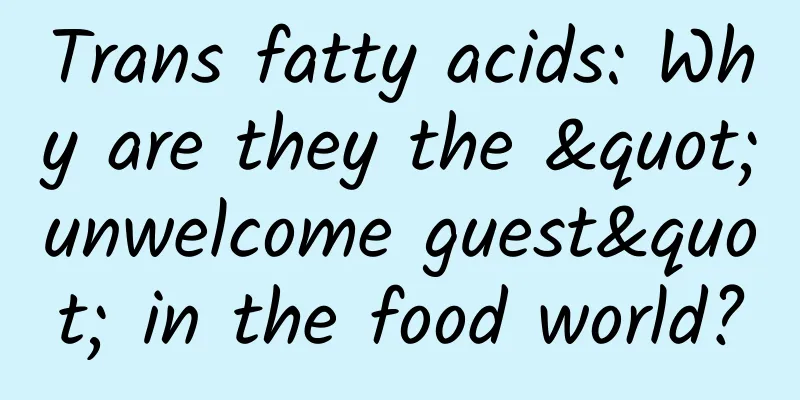Trans fatty acids: Why are they the "unwelcome guest" in the food world?

|
We often see words like "zero trans fatty acids" or "trans fatty acid-free" on food packaging. From these descriptions, we can probably tell that trans fatty acids are not popular. So what exactly are trans fatty acids? Why do these foods try so hard to distance themselves from them? Fats are composed of glycerol and fatty acids. The molecule of glycerol is relatively simple, while the structure of fatty acids is diverse. Different fatty acids combined with glycerol can form different types of fats. The definition of trans fatty acids in the "Nutrition Science Dictionary" is "unsaturated fatty acids containing one or more non-conjugated trans double bonds." Glycerol and trans fatty acids combine to form trans fats. So what do "non-conjugated," "trans double bonds," and "unsaturated fatty acids" mean? Fatty acids are compounds composed of three elements: C, H, and O. They can be divided into different categories according to the different structures of fatty acids. If the fatty acid molecule does not contain carbon-carbon double bonds (unsaturated bonds), and the carbons are connected by single bonds, it is called a saturated fatty acid; if the fat molecule contains carbon-carbon double bonds, it is called an unsaturated fatty acid. According to the number of carbon-carbon double bonds in the molecule, it can be divided into monounsaturated fatty acids and polyunsaturated fatty acids. Saturated fatty acids are relatively stable and not easily oxidized because they do not have unsaturated bonds. They are widely found in animal fats and are generally solid at room temperature and pressure. Unsaturated fatty acids are mostly found in vegetable oils and are generally liquid at room temperature and pressure. They are relatively unstable and easily oxidized, especially polyunsaturated fatty acids that contain multiple unsaturated bonds. Unsaturated fatty acids contain at least one carbon-carbon double bond, and there are two structures of carbon-carbon double bonds: cis and trans. If the hydrogen atoms bound to the two carbon atoms on the double bond are on the same side of the carbon chain, it is called a cis double bond; if the hydrogen atoms bound to the two carbon atoms on the double bond are on both sides of the carbon chain, it is called a trans double bond. In fatty acids containing multiple carbon-carbon double bonds, if there is only one single bond between two double bonds (C=CC=C), it is called a conjugated double bond, otherwise it is called a non-conjugated double bond. After understanding these concepts, I believe everyone has a basic understanding of what trans fatty acids are. Trans fatty acids are rarely found in nature, and most of them come from food processing. The main sources are as follows: (1) Fats of ruminants. For example, beef, mutton, cow and sheep milk and their dairy products contain a small amount of trans fatty acids, which are natural trans fatty acids. At present, it is generally believed that under normal dietary intake, natural trans fatty acids are not harmful to human health and may even have certain benefits. The trans fatty acids that we usually refer to as harmful to the human body are actually artificial trans fatty acids, which mainly come from vegetable oils. (2) Refined vegetable oil. Natural vegetable oil contains almost no trans fatty acids, but the edible oil we usually use is generally obtained after a series of processing and refining. During this process, a small amount of cis-unsaturated fatty acids in vegetable oil will turn into trans fatty acids. (3) Hydrogenated vegetable oil. Since unsaturated fats are unstable and easily oxidized, people often hydrogenate vegetable oils. That is, under certain conditions, hydrogen is added to the vegetable oil to allow the carbon-carbon double bonds in the unsaturated fatty acids to undergo addition reactions with hydrogen atoms. In this process, some double bonds become saturated bonds, and some double bonds may undergo structural changes from cis to trans. If it is a fully hydrogenated vegetable oil, all double bonds are hydrogenated to become saturated fatty acids, so it does not contain trans fatty acids; if it is a partially hydrogenated vegetable oil, it may contain trans fatty acids. However, fully hydrogenated vegetable oils only have saturated fatty acids, which are too hard and have little practical value. Generally, incompletely hydrogenated vegetable oils are used. Hydrogenated vegetable oil can be mixed with some ingredients or additives to make margarine, non-dairy creamer, cocoa butter substitute, etc. If there are words such as hydrogenated vegetable oil, margarine, vegetable butter, margarine, vegetable butter, non-dairy creamer, creamer, cocoa butter substitute, etc. on the food packaging, you need to pay special attention to the content of trans fatty acids in it. However, with the improvement of vegetable oil hydrogenation technology, the content of trans fatty acids in it is also constantly decreasing. my country's national food safety standard "GB28050-2011 General Rules for Nutrition Labeling of Prepackaged Foods" stipulates that when food ingredients contain or use hydrogenated and/or partially hydrogenated fats during production, the content of trans fatty acids should also be indicated in the nutrition information table. If the trans fatty acid content is ≤0.3g/100g (solid) or 100mL (liquid), the trans fatty acid content can be marked as 0. Through the ingredient list and nutrition label, we can know whether the product uses hydrogenated vegetable oil and the content of trans fatty acids in it. It should be noted that for foods that do not use hydrogenated vegetable oils, the country does not have mandatory regulations to label the trans fatty acid content. Therefore, the absence of trans fatty acids on food packaging does not mean that it does not contain trans fatty acids. (4) Improper processing. In daily cooking (especially frying, deep-frying, and baking), heating cooking oil for too long or at too high a temperature may also produce trans fatty acids. Polyunsaturated fatty acids can provide a variety of essential fatty acids needed by the human body and are beneficial to human health, while saturated fatty acids and trans fatty acids are not essential fatty acids. Studies have shown that a large intake of saturated fat and trans fat in the diet increases the risk of cardiovascular disease. In 2018, the World Health Organization recommended that no more than 10% of daily calorie intake should come from saturated fat, and no more than 1% from trans fat. At the same time, it is recommended to replace foods containing saturated fat and trans fat with foods containing polyunsaturated fat. As consumers, we should eat a balanced diet, eat more fresh vegetables and fruits, try to avoid eating foods containing trans fatty acids (pay attention to the food nutrition label), eat small amounts of foods high in saturated fatty acids (animal fats such as pork, beef and lamb), eat a moderate amount of foods high in polyunsaturated fatty acids (fish, rapeseed oil, olive oil, etc.), and try to avoid high-temperature frying and prolonged heating in daily cooking. References: [1] Zuo Dan, Wang Nini. Research progress on the hazards of trans fatty acids in food and reduction and control technologies[J]. Food Safety Guide, 2020(18):40-43. [2] Wang Zhenkun. About fat, fatty acids and cholesterol[J]. Liver Doctor, 2020(01):34-35. [3] Ruan Guangfeng. Balance and moderation: the way to get along with the "fatty acid family" [N]. China Pharmaceutical News, 2018-07-05(008). [4]. WHO recommends reducing intake of saturated fat and trans fat[J]. Food and Machinery, 2018, 34(05): 220. [5] GB28050-2011, General rules for nutrition labeling of prepackaged foods[S]. (Some pictures are from the Internet. If there are any copyright issues, please contact us) |
<<: If you don’t change these habits, osteoporosis may occur earlier! See if you are affected...
>>: Solar flares: Will the sun's sneeze eat up radio signals?
Recommend
Apple released iPhone X and other new products. We sorted out the comments and complaints from foreigners.
This morning, Apple held its autumn new product l...
Tik Tok live broadcast operation skills (super detailed)
The short video live broadcast room started a new...
As a programmer, these are the ten things you should invest in most
[[147539]] If you are already a very good program...
Dabohui's live streaming sales system course from entry to mastery, four major instructors will guide you to play Douyin live streaming sales
Dabohui's live streaming sales system course f...
Standards help small and medium-sized enterprises to implement digital transformation and make it more practical and detailed
The "14th Five-Year Plan for Digital Economy...
Low-profile phones can also use native, "light version" system Android Go is here | JuTou
At the Google I/O Developer Conference in May thi...
Popular Science Illustrations | One Picture Reveals the Key Technologies Behind Express Delivery
...
China App Rankings in Q2 2016: The unstoppable dark horse and the unbeatable leader!
The freshly released “2016 Q2 China App Rankings”...
The weather is too hot and you want to "fly up to the sky" to teach the sun a lesson? Here are three ways to do it
"I want to fly up to the sky and stand shoul...
Analysis of Zhihu’s operation and promotion strategies!
On August 12, 2019, Zhihu completed its F round o...
Case analysis: How to implement promotion and operation layout strategy on Zhihu?
How to promote products or individuals on the Zhi...
How can a novice quickly build an information flow account? Teach you how to do it in 3 steps!
Many optimizers who have just started to work on ...
A complete set of fission activity skills!
I was so angry. I saw a teacher talking about fis...
If "live suicide" happens in the circle of friends
Social relationships on WeChat are closer, so the...
Tips for writing event planning proposals!
Every small event requires countless discussions,...

![[Smart Farmers] Is the “fresh and clean” Aster a “nutrient plunderer” with great destructive power?](/upload/images/67f213e04101d.webp)







